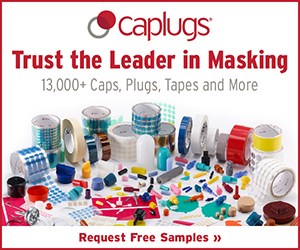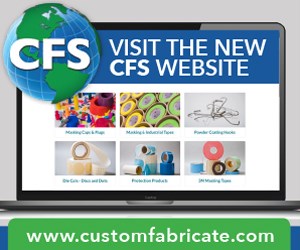Removing Cured Powder Coatings
Question: What methods are available for removing cured powder coatings, and what are the pros and cons of these methods?
Question:
What methods are available for removing cured powder coatings, and what are the pros and cons of these methods? Thanks in advance. B.D.
Answer:
Now here’s a great topic that we haven’t discussed before. Every powder coater has to face this problem eventually, either for cleaning racks and hangers or stripping parts that were rejected. In either case, the methods remain the same. The only exception is when a part requires spot repair. In this case, the defect area is usually sanded to bare metal, feathering the edges to ensure that the area will blend into the surrounding surface. The part should be processed and fully covered after sanding to complete the repair. Liquid touchup paint can be substituted for the powder coating if the repaired area is relatively small.
Now we can deal with stripping methods, which by definition require the complete removal of all the powder coating from the part or hanger. Stripping methods can be broken down into four general categories: mechanical; thermal; thermochemical; and chemical. We will examine each of these separately and discuss their drawbacks.
Mechanical stripping methods entail the use of blasting media. This media can be sand, water, CO2 pellets, glass bead, steel shot, plastic media, slag, oxides, garnet, etc. As the name implies, these media are “shot” at the coated surface, removing the coating via abrasion. Choosing the right media will affect both the speed of coating removal and the profile left on the part’s surface. The most aggressive blast media will remove the coating the fastest but can leave the roughest profile on the metal’s surface. This is not normally a problem when this method is used to clean racks and hangers but can be detrimental to the surface of a repaired part. There are more gentle blasting media, like plastic media, that can strip the coating and leave the product surface with a smooth profile. But, cleaning time with these materials can be a bit longer. Sometimes this method is used in conjunction with other stripping methods, such as removing the ash left on a product that was thermally cleaned. Mechanical cleaning systems can be automated or batch operations.
Thermal cleaning methods use heat to breakdown the coating and turn it into an ash residue, usually removed by water or media blasting. There are three types of thermal cleaning methods: bake-off; burn-off; and fluidized bed. The key to this method of stripping is that the hangers or parts must be resistant to the temperatures employed in the process. Parts that are made of magnesium or have soldered joints would not be good candidates for this stripping process, since temperatures can be as high as 1,200F.
Bake-off stripping systems are batch-type processes where parts and/or hangers/racks are loaded into the oven for cleaning. The oven temperature is set between 650-750F, which is generally the temperature where the coating will degrade and eventually ignite. The byproducts of this process (VOCs) are often destroyed by afterburners in the exhaust stack. These ovens usually employ water-misting systems to control the rate of burning and prevent damage to the equipment or parts/hangers being stripped. This process will not completely strip the product to bare metal, and the residual ash must be removed to prevent fouling of subsequent pretreatment, coating and curing processes.
Burn-off stripping systems expose the products to be stripped to much higher temperatures, between 1,000-1,200F. At these temperatures, the coating ignites quickly and literally burns away from the product. Normally these systems are used as inline processes, either directly on the process conveyor or on spur lines operating at up to 6 fpm. Water quenching is used to extinguish the fire and to remove the residual ash. This means the products are completely cleaned when they exit this process. This method of stripping is more effective on hangers and racks than on products, since the higher temperatures can warp the parts.
Fluidized bed stripping systems use inert media (sand or oxides) as a heat transfer medium. Basically, these systems ignite natural gas or propane in a chamber below the tank and force this heat through the medium using air pressure. The heat is transferred to the medium and the gas/air pressure “fluidizes” the medium, just like a fluidized powder hopper. Hangers or products are lowered into the fluidized tank where the hot medium (approximately 800F) breaks down the coating, and the scrubbing action of the medium removes any ash. Parts or hangers removed from this process are essentially clean and require no additional cleaning efforts. Normally these systems are used in batch type operations, but they can be automated for inline processing of hangers.
Thermochemical cleaning methods use a combination of temperature and chemical reaction to strip the coating from the part. Most often referred to as “molten salt” cleaning, this methodology is used to strip both products and hangers in a relatively short cycle time. The operating temperature is about 800-900F. This process is used as an inline stripping method and uses a water spray to clean chemicals and residue from the parts/hangers.
Chemical stripping methods can use either hot or cold stripping chemistries in a batch-type process to remove the coating from parts/hangers. The hot strippers are usually caustic and degrade the coating from the part by causing it to swell, dissolve, etc. This softened coating is then removed by water spray or just falls off into the chemical bath. Cold chemical strippers are usually solvent-based products and can be very dangerous to work with because of health concerns. Knowing how resistant to chemicals powder coatings are makes one think how nasty these cold strippers can be.
The stripping method of choice should be selected based upon the following criteria:
- How fast do you want to strip the coating from the part or hangers? This is a great example of “time is money,” since most of the faster stripping methods are usually the most expensive to purchase and operate. Mechanical stripping can take 30-120 min to process only a few parts but is often one of the cheapest processes to implement. Bake-off systems can take 3-6 hr to strip the coating off the parts/hangers while burn-off systems can be as quick as 4 min. Fluidized beds are relatively quick at 30-60 minutes but can’t match the speed of thermochemical strippers where racks can be stripped clean in just seconds. Finally, chemical strippers can strip parts at 30-60 min.
- Do you have to perform some post-stripping cleaning to remove residue? The methods that provide the cleanest parts/hangers without any additional steps are most appropriate for inline stripping systems.
- Do you need a batch or inline stripping process? Inline systems are always more expensive than batch stripping systems. However, having enough hangers to support a batch type stripping process can be more expensive than buying an inline stripper in high-production powder coating systems.
- What effect will the stripping process have on the hangers and/or parts? If you process lightly made parts or hangers through an aggressive cleaning system, then you may be scrapping more hangers or parts than you would like.
- What environmental and/or health considerations need to be evaluated? Cold chemical strippers are often too dangerous to use and difficult to dispose while bake-off systems are normally environmentally friendly.
Often the stripping time vs. capital costs argument determines which process you will select. But don’t forget the operational cost of the system you select. Sometimes the cheapest process to buy is the most costly to operate. And, finally, you should provide sample parts/hangers to the equipment suppliers for testing before you purchase any stripping process. This ensures that you and the supplier will have similar expectations of what the hangers/parts will look like after they are stripped free of the powder coating and how much effort it will take to get them stripped.
Related Content
Trivalent Chrome Overview
As the finishing industry begins to move away from the use of hexavalent chromium to trivalent chromium, what factors should finishers consider as they make new investments? Mark Schario, chief technology officer for Columbia Chemical offers a helpful overview of this complicated topic.
Read MoreHow to Choose the Right Coating for Fasteners
Choosing the proper coating for fasteners can help with performance by improving durability and lifespan. In this helpful Ask the Expert article, Mark Schario of Columbia Chemical offers advice for choosing the right fastener coatings.
Read MoreGlass Bead Blasting as Plating Pretreatment
What are the best practices for using blasting in preparation for plating? Angelo Magrone of Bales Metal Surface Solutions discusses the ins and outs of glass bead blasting.
Read MoreCrazing and Cracking in Anodizing
Understanding the differences in cracking and crazing in anodic coatings, and insights for mitigating defects in anodized parts.
Read MoreRead Next
Episode 42: An Interview with Robin Deal, Hubbard-Hall
Hubbard-Hall wastewater treatment specialist Robin Deal discusses the latest trends in wastewater management.
Read MoreThe 2024 Ford Mustang: All the Colors Available
Although Chevrolet has announced the end of the Camaro and Dodge is offering “Last Call” editions of the Charger and Challenger, the Ford Mustang is launching to its seventh generation.
Read MorePowder Coating 4.0: Smarter, Faster, More Efficient and Connected
New tools reduce cost and waste, lower manufacturing footprint of powder coating operations.
Read More





























